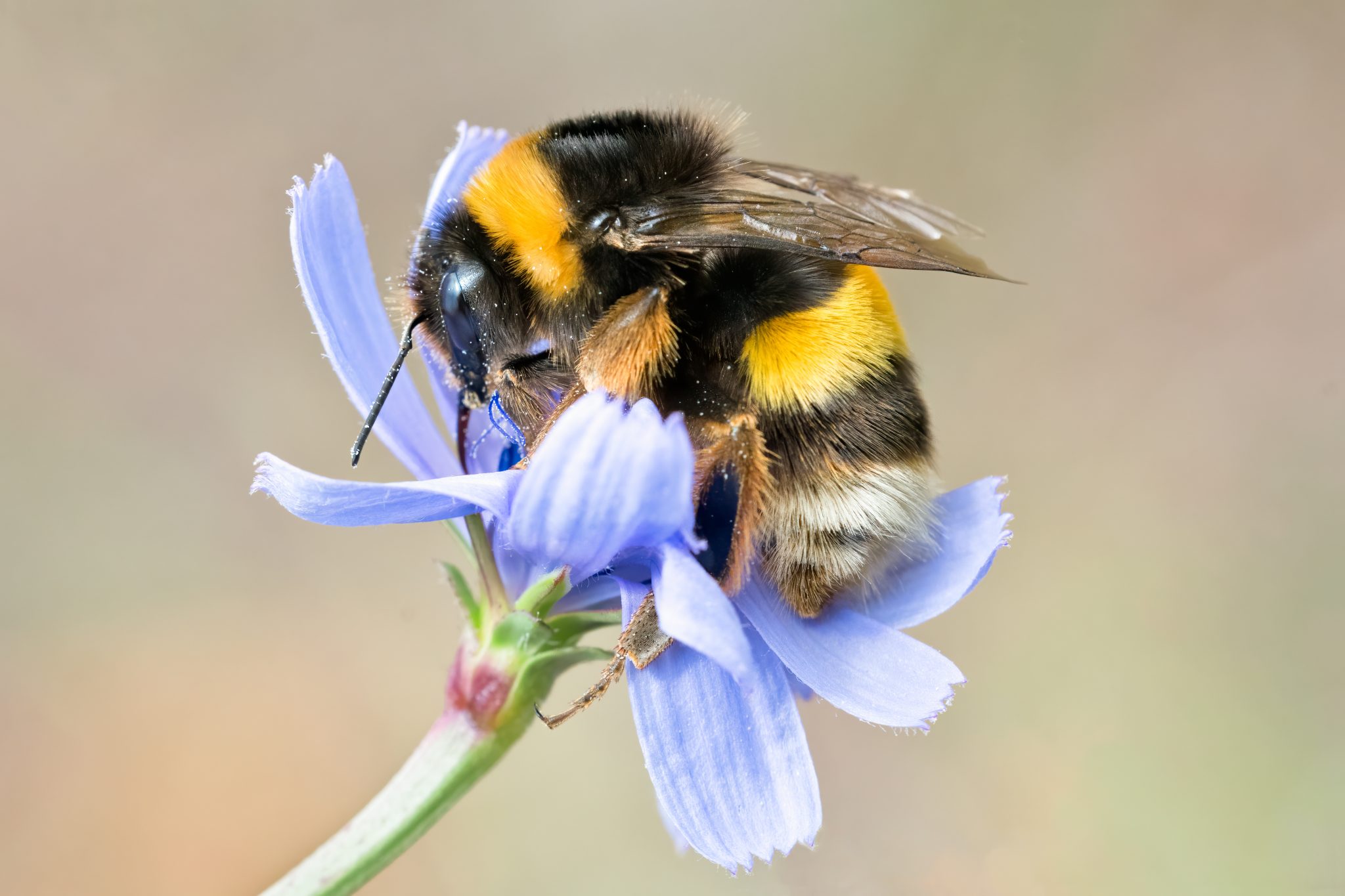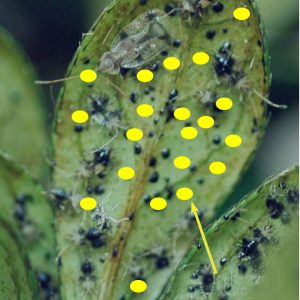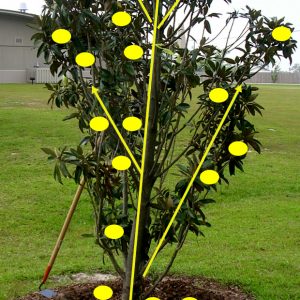Bees & Pollinators

The third in the Protecting Pollinators in Urban Areas series focuses on the safe use of pesticides. You will learn pesticide types and how they differ. You also will gain a handy list of common pesticides and their effects on pollinators.
Urban landscapes with plants that flower throughout the season can be great resources for native bees, such as bumble bees, to gather nectar and pollen. Unfortunately, ornamentals and turfgrass are prone to pest outbreaks that require the use of pesticides to prevent severe damage. Improper use of pesticides can contribute to pollinator declines. Knowing what to look for in buying and applying pesticides is important to the preservation of pollinators.
How Insecticides Work
Pesticides are grouped by the chemical nature (called chemical class) and how they provide control (mode of action). Active ingredients in pesticides are the portion of the product that provides control.
Insects must be exposed to insecticides to be controlled. Some insecticides simply cover the leaves, while others enter plant sap.
For direct contact to work, the pest must walk or crawl on the treated surfaces. Insecticides that penetrate the plant affect either the leaves (called translaminar) (figure 1) or the plant as a whole (systemic) (figure 2). The pest is exposed to the toxin during feeding. These varieties of pesticides are popular because they protect plants from certain pests for several weeks or even months.
- Figure 1. Spray applied only to the top side of the leaf. Pesticide moves to the underside of leaf where pests are feeding.
- Figure 2. Insecticide applied to the soil or leaves moves into the plant sap and travels to leaves and branches.
All Pesticides Are Not Created Equal
Pesticides comprise a group of chemicals formulated to kill pests of many kinds. They include insecticides to control insects, herbicides for weeds, and fungicides for plant diseases.
Pesticide use in any outdoor landscape (yards, farms, nurseries) may create hazards for pollinators that visit treated plants. Direct contact with many common herbicides or fungicides does not cause immediate mortality of bees (called acute mortality). Many insecticides, on the other hand, do cause acute mortality. One example is the insecticide imidacloprid, found in many consumer products. A 2015 report by the Environmental Protection Agency found seventeen reported pollinator kills over a seven-year period related to the use of the insecticide, mostly in urban areas or on ornamental plants.
This does not mean that pesticides, including imidacloprid, cannot be used safely; rather, they must be used in a way that prevents pollinators from being exposed to excessive levels of the active ingredient.
Just as smoking can cause long-term health problems in humans, certain pesticides can cause problems for pollinators when the insects are exposed to small amounts over time. These doses are called chronic exposures. Exposure can come from pesticides on plants or in their food (pollen or nectar). The levels of these toxins are not lethal immediately but can cause problems with behavior, reproduction, and survival. Some studies have shown that a queen bumble bee exposed early in life to flowers on pesticide-treated plants can result in the colony being less able to produce new queens later.
Read the Label Before You Buy
Before you buy any pesticide, read the label. Many pesticides labels are concealed under a flap, but it is acceptable to open the flap in the store to read the label.
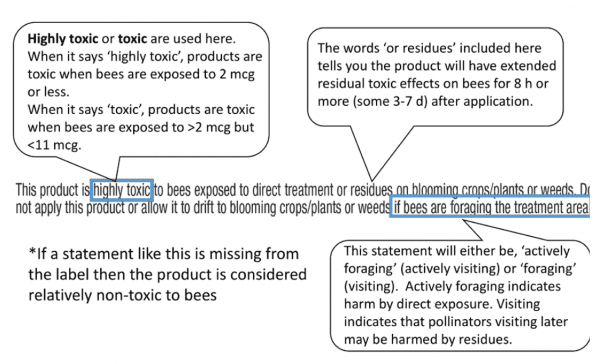
Toxicity: Statements on labels like these contain terms that indicate the relative toxicity of the product, how long a treatment may affect pollinators, and the conditions under which the product should not be applied.
Every label is required to have a special section called “Precautionary Statements” (figure 3). It includes key words indicating the toxicity of the product to bees and how long an application will remain a hazard to them. Look for the word “residues” in the first sentence (figure 4). Residues indicate a lasting effect of a treatment for plant protection. While these residues can be beneficial for protecting plants from pests, it is also one route where pollinators could be exposed to pesticides. Choose products that list your target pest but also have minimal impact on bees. The key word here is “actively,” usually listed before the words ‘foraging’ or ‘visiting’. Foraging or visiting refers to flower visits by pollinators, usually to the flowers but sometimes the treated plant also. Be aware that some products for use on ornamentals may not have a bee precautionary statement.
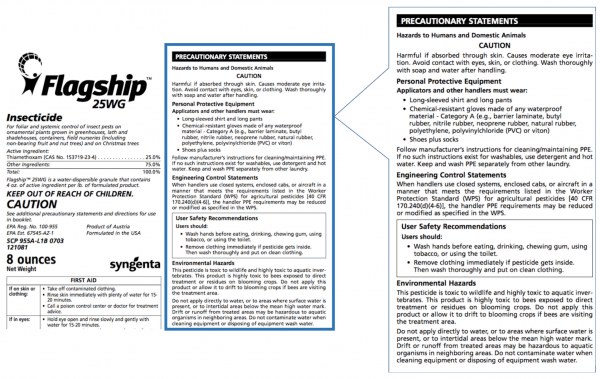
Label and precaution: The precautionary statements on the label list the potential hazards to the person applying the pesticide as well as environmental hazards.
Monitor Application Method, Rate, and Frequency
The pesticide formulation and method of application can influence the hazard level of different active ingredients.
Pesticides are applied in a number of ways. The delivery method depends on the chemical nature of the pesticide. Some are applied to aboveground plant parts as sprays (the most common method). Others are added to the soil in the form of granules or liquid sometimes called drenches). Still others are injected into the plant trunk (professional use only).
A granular formulation of imidacloprid applied to a weedy lawn is less hazardous to pollinators than the same rate of that material applied as a foliar spray. This may explain why the precautionary statement can read differently for products that contain the same active ingredient.
Insecticides applied by trunk injections, soil applications, or sprays are designed to remain active on leaves, stems, or even flowers (residual activity), but these residues can be hazardous to pollinators. Direct contact with foliar residues is one of two precautions on the bee advisory box on pesticide labels (figure 5). The second precaution concerns ingestion of residues in pollen and nectar. Use of systemic insecticides applied to soil (granular or liquid formulations) or as trunk injections will move into the plant and possibly into the flowers.
Precise rate and frequency of application are crucial. Never guess the amount of pesticide you are applying.
Two concerns with application methods are use rate (amount) and frequency. Most people are unaware that systemic insecticides are applied at a much higher rate to ornamentals and turfgrass than to all other agricultural crops.
A study from the University of Minnesota illustrates the damage that can be done to valuable insects. A systemic insecticide was applied in water to the soil of butterfly weeds at the label rate and at double the label rate. Following application, researchers sampled flowers for pesticide residues and evaluated the impact on lady beetles and caterpillar larvae. The flowers from the double-rate plant had approximately 58 percent more residue. And the residue levels from both application rates were significant enough to negatively impact lady beetles and reduce survival of caterpillars of the Monarch and American painted lady butterflies. The study additionally found that plants treated 7 months after the first application using the same rate had up to 4 times more insecticide residues in their flowers.
What does this mean to you as a consumer?
When you buy an insecticide, the product label will tell you how many pesticide applications you can make per year. But you may not know if, when, or with what insecticide the plant may have already been treated. New labeling on plants at certain large retail garden centers may indicate the use of systemic insecticides, but they often will not list when or which insecticides were used. Be mindful of overusing them, particularly if applying in the same year.
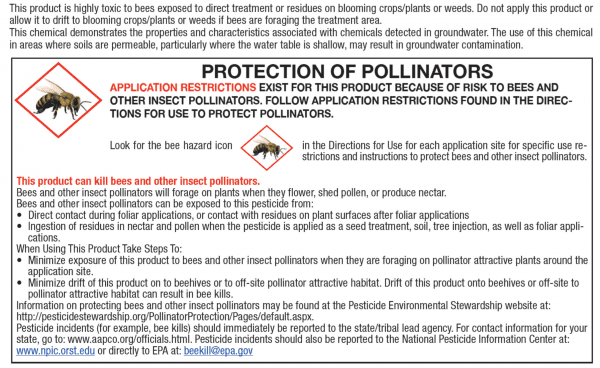
Bee box: Pesticide labels contain a section specifically listing potential hazards to pollinators. This is referred to as the “bee box.”
Insecticides and miticides used in turfgrass or ornamentals and their relative hazard to pollinators
Some products listed here are only available for sale or use by professionals with a valid pesticide license. Read and follow all label directions relative to use of your product.
Blue: active ingredients considered highly toxic or hazardous
Black: active ingredients considered moderately hazardous
Green: active ingredients considered relatively nonhazardous
* product with systemic properties
| Active ingredients | Example products |
|---|---|
Abamectin | Avid, Minx |
Acephate* | Orthene |
Azadirachtin | Neem, Bioneem, Azatin,Molt-X |
Bacillus thuringiensis kurstaki | Dipel, Thuricide |
Bacillus thuringiensis galleriae | beetleGone, grubGone |
Bifenazate | Floramite |
Bifenthrin | Talstar, Ortho Bug-B- Gone Insect Killer |
| Buprofezin | Talus |
Carbaryl | Liquid Sevin, Sevin dust |
Chlorantraniliprole* | Acelepryn |
Chromobacterium subtsugae strain PRAA4-1 | Grandevo |
Clothianidin* | Arena |
Cyflumetofen | Sultan |
Cypermethrin | Cynoff, Cyper |
Deltamethrin | Deltagard, Hi-Yield Turf Ranger Insect Control |
| Dicofol | Kelthane |
Dinotefuran* | Zylam, Safari |
Emamectin-benzoate | Arbormectin |
Etoxale | TetraSan |
| Fenazaquin | Magus |
Fenbutatin oxide | ProMite |
Fipronil* | TopChoice, Chipco Choice |
Fluvalinate | Mavrik |
gamma-Cyhalothrin | Spectracide Triazicide Insect Killer |
Insecticidal soap | M-Pede |
Imidacloprid* | Merit, Bayer Advanced Tree and Shrub |
Indoxacarb* | Advion-brand products, Provaunt |
Isaria fumosorosea Apopka strain | Preferal |
Lambda-cyhalothrin | Scimitar, Bonide Caterpillar Killer |
Milbemectin | Ultiflora |
Mineral oil and horticultural oils | Suffoil-X, Dammoil, Volk oil |
Permethrin | Astro, Hi-Yield 38 Plus Turf, Termite, and Ornamental |
Pyriproxifen | Distance IGR |
| Pyrometrozine | Endeavor |
Spinosad* | Conserve, Entrust |
| Spiromesifen | Forbid |
Thiamethoxam* | Meridian, Flagship |
Trichlorfon | Dylox, Fast acting grub control |
Zeta-Cypermethrin |
Protecting Pollinators in Urban Areas Series
- “Pollinator Ecology, ANR-2409
- “Use of Flowering Plants,” ANR-2419
- “Reducing Hazards from Pesticide Use,” ANR-2420
- “Safe Use of Integrated Pest Management,” ANR-2387

